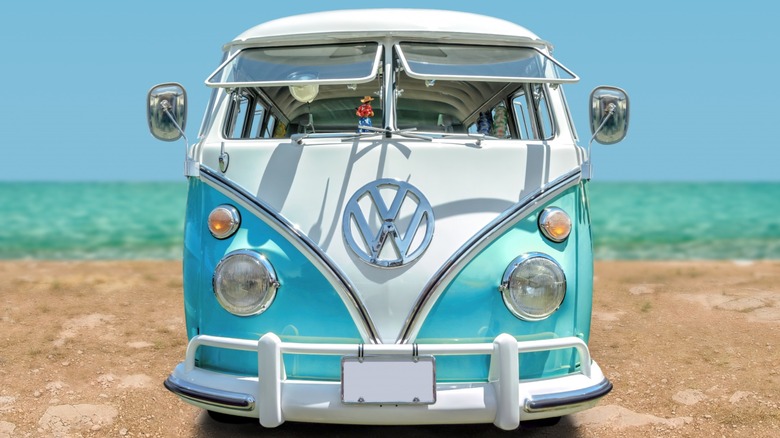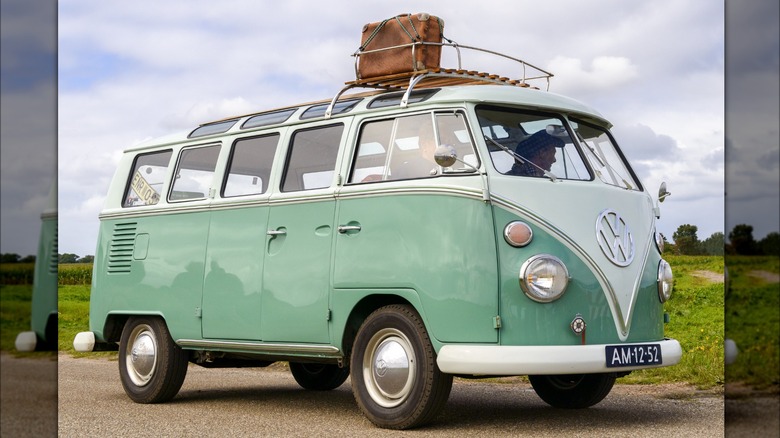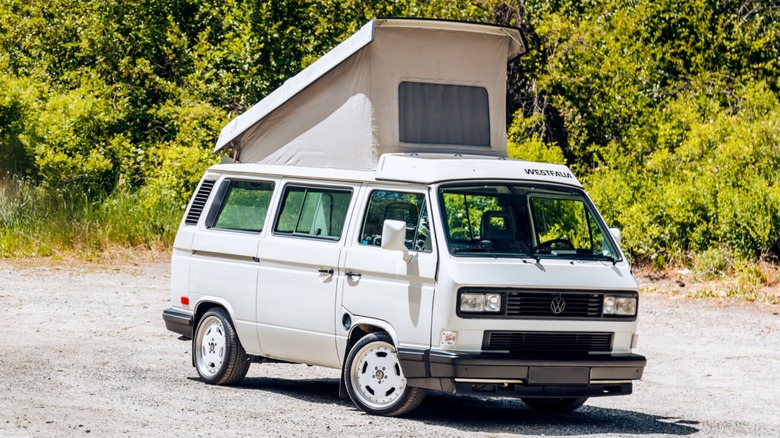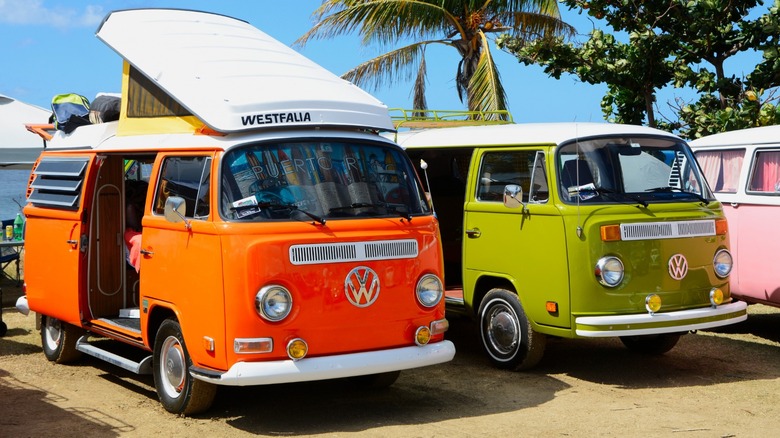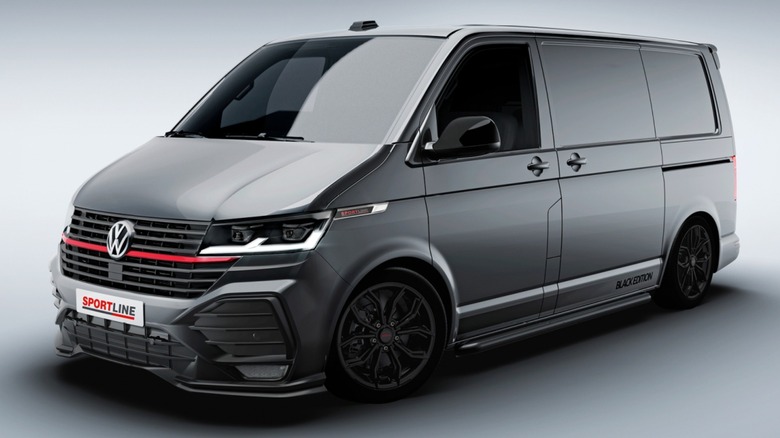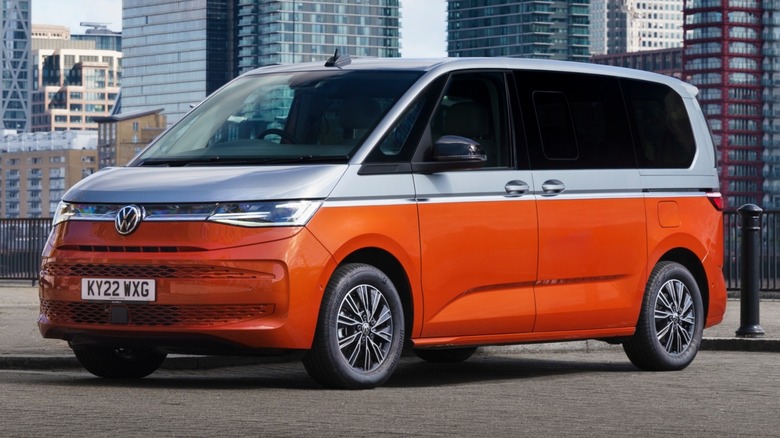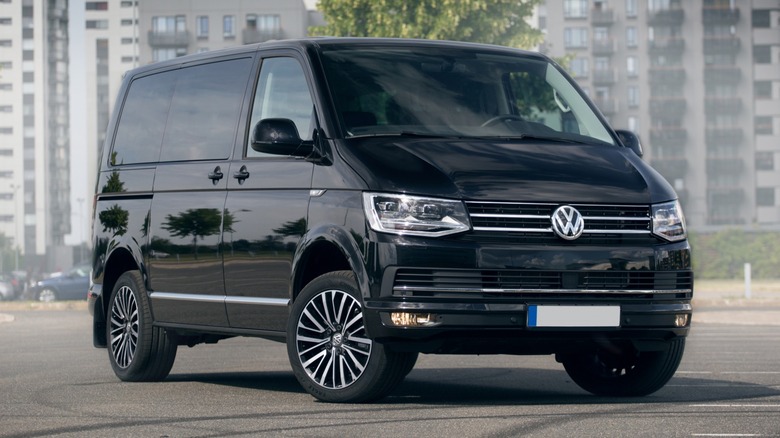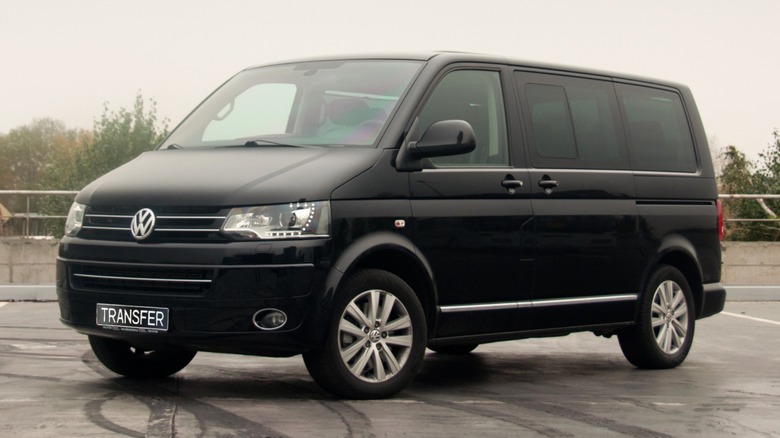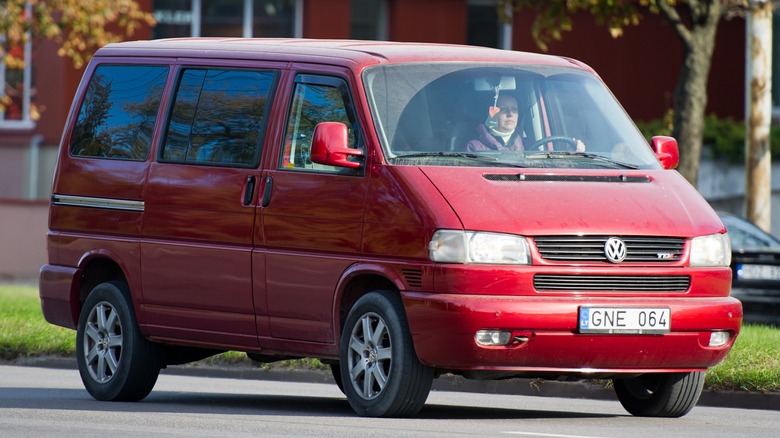Ranking Every Generation Of Volkswagen's Transporter, Best To Worst
The indomitable Volkswagen Bus, officially known as Transporter but also called Microbus, is a worldwide favorite. Based on the legendary Type 1 Beetle, VW created the bus as a reliable and affordable means of moving people and cargo around a war-torn country in the process of rebuilding. Furthermore, creating a people mover using the chassis of an automobile was a genius move that created economies of scale with a tremendous amount of parts sharing, keeping costs low. Furthermore, the exterior design, which was a practical consideration, had the added benefit of being charming with an enduring style.
In its home country, the Bus became an integral part of society by serving as a minibus, contractor vehicle, mail hauler, and more. Elsewhere, such as in the United States, it became a quirky and fun anomaly on streets ordinarily occupied by much larger and more robust platforms. This prevented its widespread adoption as a serious work vehicle, but it did make a curious alternative to mainstream domestic transportation.
At some point during the '60s, people involved in counterculture movements, the so-called hippies, adopted the VW Bus as a vehicle of choice. While that culture and counterculture has waxed and waned, the Bus soldiered on in production, changing forms a few times until it reached the modern day looking nothing like the original. Now that VW has revived the original concept with its forthcoming electric ID.Buzz, and with close to 75 years of history, let's take a look at how the iconic VW Transporter has evolved over many generations while ranking them in increasing order of utter goodness.
1. VW Transporter T1 (1950-1967)
The Marshall Plan enacted after WWII sought to quickly reinvigorate the German economy and bring the country back into the international fold of diplomacy and trade as quickly as possible. Therefore, under British supervision, VW started up quickly and produced the Type 1 Beetle by 1946. Within just four short years, the Type 1 chassis had been adapted to a vehicle capable of moving people, goods, and supplies. It was called the VW Type 2.
The Type 2 design is simple, riding on the Type 1 chassis with few modifications. The body is expanded to all corners to maximize shape but also rounded to give some aerodynamic benefit. The engine was initially the same 1.1-liter boxer, making the Bus woefully underpowered. Regardless, sales took off, especially in its home country where money was scarce and the need was great, soon selling so well it became ubiquitous doing duty as ambulances, fire trucks, taxis, and delivery vans. It was less successful across the Atlantic until VW's inventive advertising of the early '60s drove buyers to the showroom.
T1 models have since become surprisingly and extraordinarily valuable, especially the 23-window versions. Comedian Gabriel Iglesias, aka Fluffy, owns a considerable collection with multiple examples worth $200,000 or more. Upgrades were applied to the Bus throughout its run, and by its end in 1967, the engine had grown to 1.5 liters with 42 horsepower, giving drivers a fighting chance in moderate traffic while also allowing companies to create conversions like the popular Westfalia camper van.
2. VW Transporter T3 (1979-1991)
With increasing emissions regulations coming into force, VW found a good reason to update its successful Bus one more time, although VW Brazil continued T2 production until 2013. The new Transporter started production in 1979 and came to the United States as the Vanagon. The design was subjected to a complete overhaul, creating a much more modern design with sharp corners, a lack of chrome, and a much more upscale and comfortable interior. The most significant change, delayed until 1981, was the switch to water-cooling for the engine — the wasserboxer.
Unfortunately, early wasserboxers came with many problems from poor engine cooling to leaking head gaskets. Once these issues were ironed out, the Vanagon sold well due to a combination of versatility, appealing idiosyncrasies, and many more amenities than the previous model. With the water-cooled engine, VW offered buyers power steering, air conditioning, power locks, power mirrors, and plentiful interior lighting. Power rating improved with the wasserboxer engines, with up to 112 horsepower for the 2.1-liter. While better, this still did not make for a speedy drive, especially when laden with camping equipment for a Little League team.
VW ended T3 production in 1991, although it continued in South Africa until 2002. This model now looks every bit like a product of the '80s, but for vintage VW lovers, this generation is the best bet for a Bus that can be lived with -– and, indeed, lived in -– with a degree of modern comfort, which is causing values to rise, particularly the Westfalia conversions.
3. VW Transporter T2 (1967-1979)
After nearly two decades of production, it was time to update and upgrade the popular Volkswagen Bus. Several noticeable changes were incorporated into it along with mechanical upgrades underneath. Most prominent among these were the windows. Multiple small windows were replaced with larger ones, and the front windows were replaced with a single curved bay windshield. Some say it was not as attractive, but the improvements resulted in a better vehicle.
Engine displacement initially rose to 1.7 liters, and by 1978, you could buy a T2 with a fuel-injected 2.0-liter engine paired with an automatic transmission. Upgrades for the suspension came with the redesign, adding independent suspension to the rear and upgrading the front. Other changes included larger and additional vents for better airflow, the first-ever sliding side door, disc brakes, and several smaller styling changes throughout.
Conversions became even more popular with this model and the more efficient options made it possible to carry the added weight. By all accounts, regardless of whether it was more or less attractive, the T2 was an all-around better vehicle. Further variants turned it into trucks, delivery wagons, and other work vehicles, but the infamous American Chicken Tax prevented anything but a passenger version from being imported.
Copies of T2 models are still relatively abundant but fast becoming scarce. They remain more affordable than T1 Buses as those continue to get snatched up by custom shops for wild restorations. That makes the T2 a good choice for enthusiasts without a Fluffy budget who still have the willingness to jump into classic VW ownership.
4. Volkswagen Transporter T6.1 (2020-2021)
In 2020, the Transporter underwent a refresh. This was not a fully reworked model but a mid-cycle update. All the mechanicals are the same as before, but the interior received an elegant new look, including an updated dashboard that looks quite nice and polished. However, the most exciting thing about this facelift was the Transporter Sportline Black Edition originally unveiled in 2019.
VW has offered Sportline as one of its top trim levels of Transporter for many years. This option will get you a more sporty exterior with flourishes such as ground effects and extra body cladding to give it a bit more aggressive look. It also comes painted in unique bold colors to complete the look. However, the Sportline unveiled in 2019 makes it something else altogether.
The T6.1 Transporter Sportline Black Edition comes in a dark gloss gray paint with custom wheels and ground effects, including a rear spoiler and bumper with large flared faux vents on the side that look reminiscent of the openings on the front of a Murcielago. It uses Eibach coilovers to lower it by an inch and the interior is treated to Nappa leather with honeycomb pattern stitching and generous use of Sportline logos. Essentially, it's a minivan for Bond villains, which makes it worth mentioning. However, it should be noted that this version continues to be produced as a commercial vehicle while the T7 Multivan is offered for passengers.
5. Volkswagen Transporter T7 Multivan (2022-present)
The current Transporter brings with it a whole lot of new tricks scattered throughout a new and appealing package. If the T6 brought VW to the modern era, the T7 takes it into the future. It is built on the same MQB platform as a wide range of current VW models and comes with familiar gas and diesel engines, but will be the first optional hybrid van from the country. While the exterior design looks great, it's what is found inside that makes it shine.
To compete in the modern day, vans need to have many toys, and VW has managed to deliver them. It has seating for seven that all ride on a track system for the ultimate in modularity and customizable layouts, which includes second-row captain's chairs that swivel 180 degrees. Best of all, the center console can also be slid all the way back to the third row and includes height adjustment.
Screens abound in front and back with USB-C connectivity and VW's Digital Cockpit on tap. This includes an integrated eSim to keep the van connected so long as it is within range of cellular service. This all makes the T7 yet another great project no American will get to enjoy — at least, not at home.
6. VW Transporter T6 (2015-2019)
The T6 Transporter, introduced for the 2015 model year, brought VW's van to the modern era. Its exterior design is sleek and fresh, taking on the corporate face seen across its current range of cars and SUVs. Engine options are the turbocharged 2.0 TSI unit delivering up to 204 horsepower or, likely the popular choice in Europe, the venerable 2.0-liter TDI diesel unit. Transmission choices have been upgraded to a 6-speed manual or the 7-speed DSG automatic. With more than 200 horsepower in its top trim, the Transporter may not be winning any hill climbs but should ferry the kids nicely on the Autobahn.
Anyone upgrading to the T6 will immediately notice significant updates in the interior. Modern touchscreen controls and color screens greet drivers with a plethora of functions. The interior design is also fresh and modern with premium materials, such as leather seating, throughout.
Not only does the T6 provide a pleasant space, but it also drives more like a car than any previous models or competing vans from other manufacturers. With its comfort and capability combined with excellent fuel economy of up to 40 mpg, it makes a good choice for those to whom it is available — which, of course, includes no Americans.
7. VW Transporter T5 (2003 - 2015)
While Americans would forever be deprived of VW's latest van technology, Europeans and others would not suffer so perilously. The next iteration of the Transporter was designed more in line with other mainstream European vans of its day. Volkswagen tech has come a long way, offering Transporter buyers many attractive options of engines, transmissions, and other extras.
Being a largely European model, the most common engine choice was the excellent 2.0 TDI diesel, with a 2.0 gasoline option available. VW had recently released its dual-clutch DSG transmission, offering it in a six-speed version in the van as an alternative to a five-speed manual. Interior design fell in line with other models such as the Passat or Jetta of the time, meaning it was attractive and of generally good quality.
The takeaway about the T5 is that it was a good option for a van, either passenger or cargo version. The other takeaway is that it was not as unique as the old Transporters had been. This was VW offering a good product for a mainstream market and not much more could be said about it. However, during this time, VW thought it could pass off a rebadged Dodge minivan to American buyers as the Routan. While VW had tweaked its suspension and put its own style to it, it was still a Dodge — even a boring Transporter would have been better.
8. VW Transporter T4 (1992 - 2003)
Beginning in 1992, American dealers received newly redesigned front-engine passenger Transporters, now renamed the Eurovan, equipped with the VW/Audi 2.5-liter 5-cylinder engine and finally killing the flat-4 forever. Sales started slowly and never took off. The 5-cylinder engine may have worked fine in an Audi sedan, but it was too little for a van, making it the slowest minivan tested by Car and Driver at the time.
Furthermore, anyone excited at the prospect of getting an updated Westfalia conversion only had a Weekender version available. It was fitted with opposed seats in the rear, a slide-out electric cooler, and not much else. The stove, fridge, and storage that made Vanagon Westies so popular were gone, but at least you could still sleep in it. VW forgot that it had to offer something unique to drive sales, and the Eurovan lacked the novelty of its predecessor. Sales got so bad it was discontinued in 1994.
VW revived the Eurovan for 1998, this time with the legendary VR6 under the hood. However, VW mystifyingly detuned the engine down to 140 horsepower. Furthermore, Volkswagen charged more than $30,000 for it, making literally any other van a better choice. Someone at VW finally got a clue and raised the VR6 output to 201 horsepower in 2002 — but it was too little, too late, as 2003 would be the last time a VW van left the Old World for the New.
